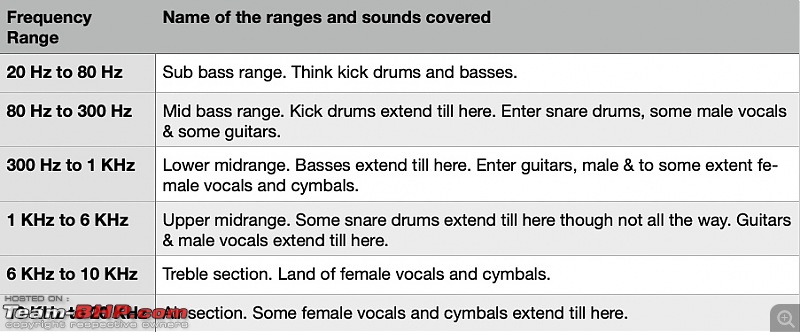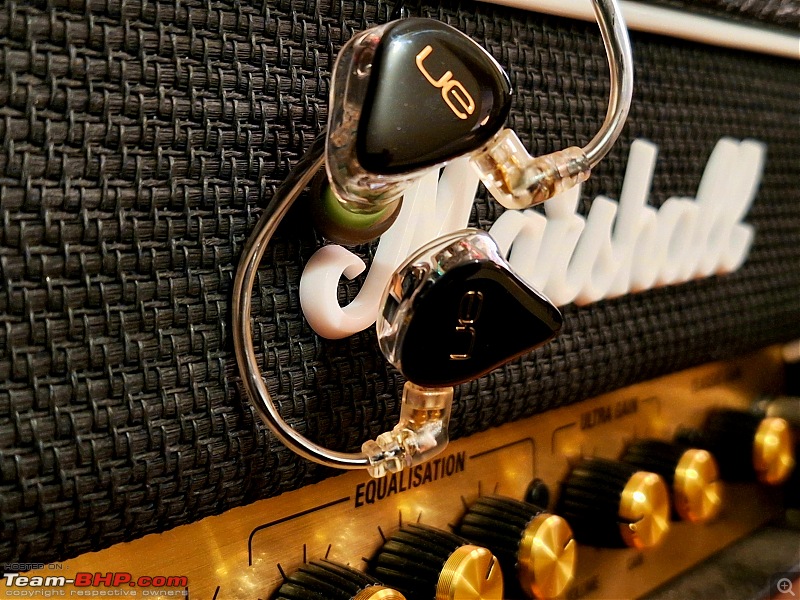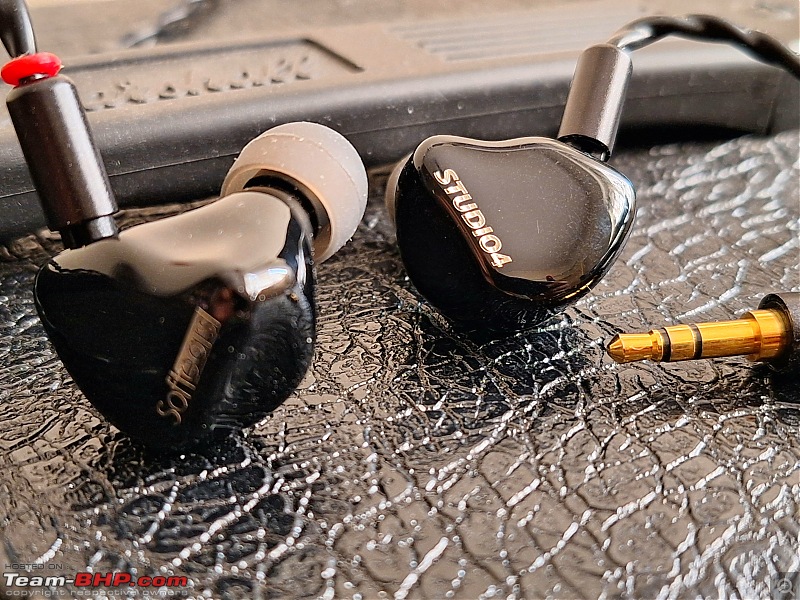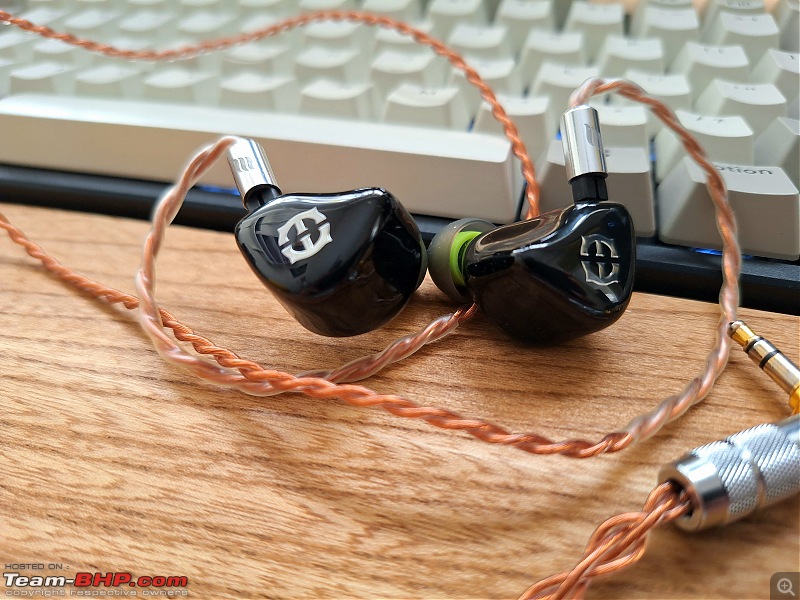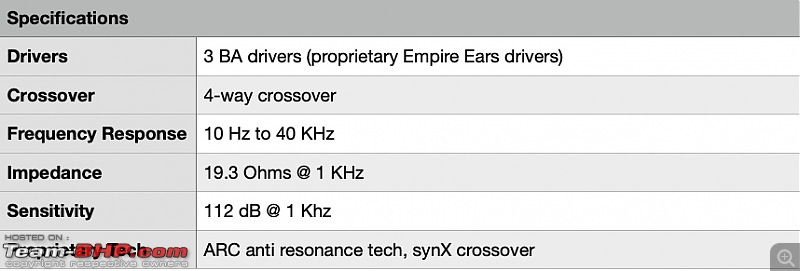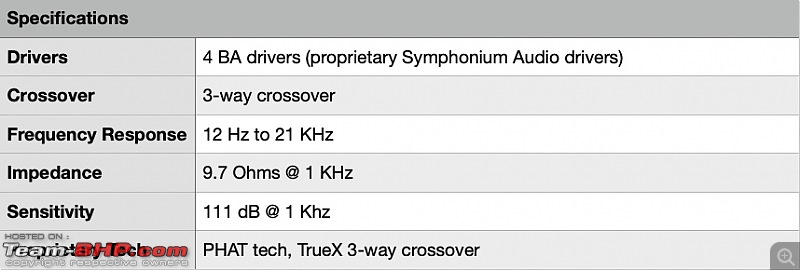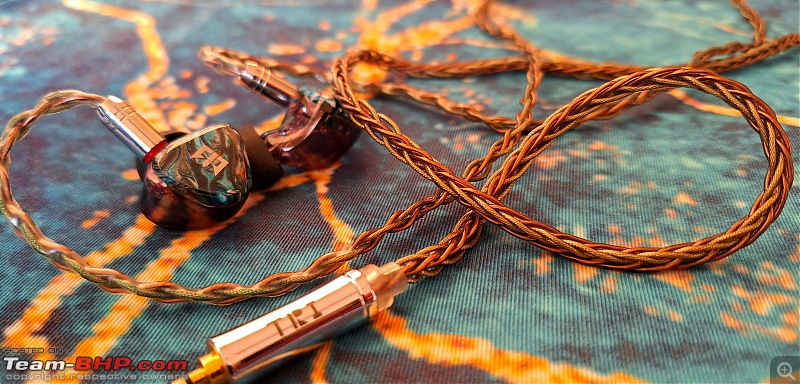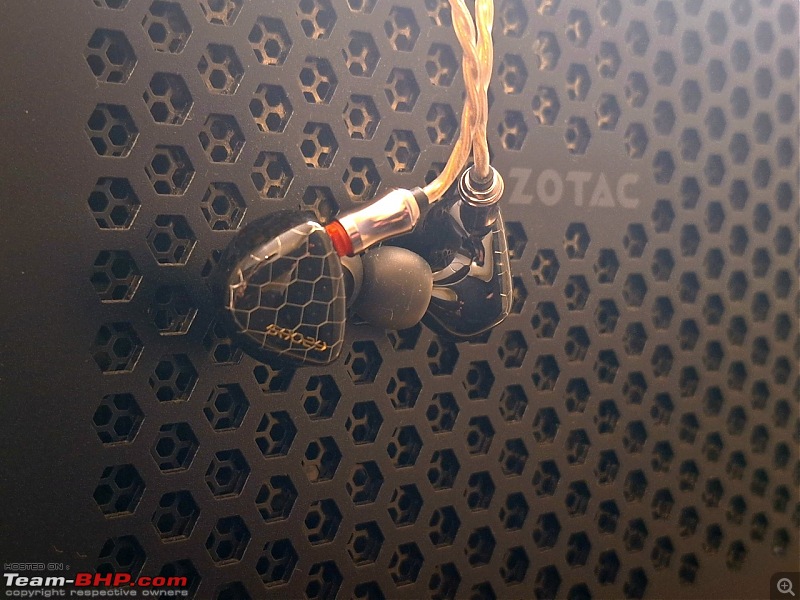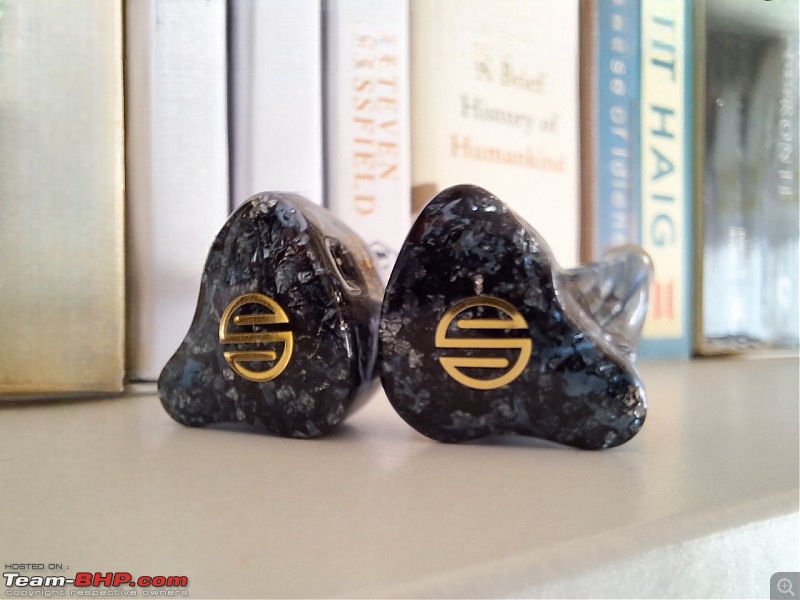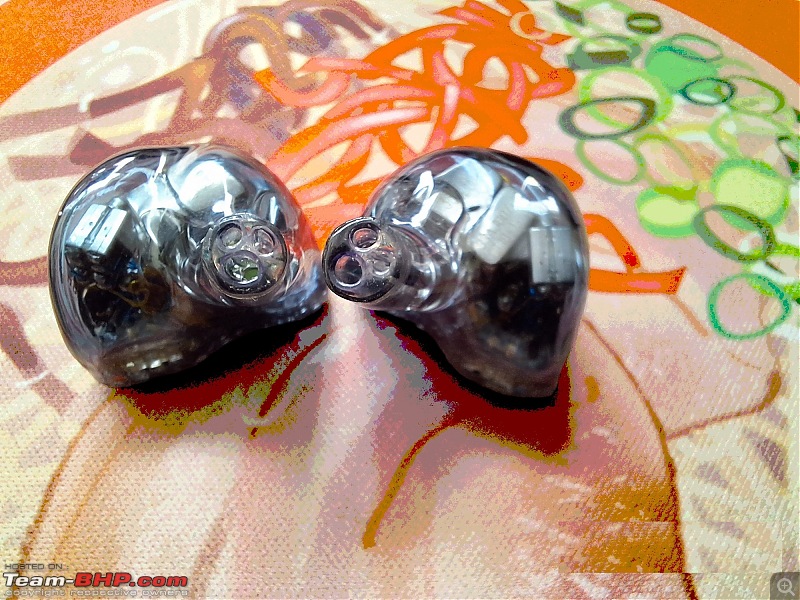| |||||||
| Search Forums |
| Advanced Search |
| Go to Page... |
 |
| Search this Thread |  7,015 views |
| | #1 |
| BHPian Join Date: Jun 2011 Location: Cochin
Posts: 169
Thanked: 421 Times
| A gathering of Mid Tier in-ear monitors (IEMs) | Ultimate Ears, Softears, Empire Ears & a lot more Introduction: After a particularly gruelling week, I had dropped by to stay at my friend’s place over the weekend for some peace and quiet. It was a pleasantly balmy afternoon and a gentle breeze played around the balcony overlooking his garden. The chirping sounds of the birds and the lush garden ensured that the din of the city’s traffic was kept at bay. I was savouring a cup of chai after a satisfying lunch when my friend came in and placed a box on the hardwood table. He grinned at me and asked me to open it. I set down the chai and took a peek inside the box. My eyes almost popped out of its sockets. There were boxes upon boxes of in-ear monitors that I had been itching to try for the longest time. My friend was an audiophile and those in-ear monitors were just a small part of his collection. He was gracious enough to let me try them out at leisure there. This was an audio enthusiast’s dream come true and the rest of the weekend passed by in a blur as I lost myself in sonic bliss. In-ear monitors or IEMs, have been around since the 80s and were primarily used by performers and TV presenters. They make perfect sense for portable use since they are discreet, isolate well and can potentially sound good. IEMs are usually made in universal shapes that fit comfortably for most of the populace and for discerning users, some manufacturers make customised IEMs based on ear impressions. I had always loved the concept of personal audio since it allowed me to listen to my favourite tracks without bothering others around me. My first in-ear earphones were the popular Creative EP-630s. I used them for a long time and upgraded to the excellent JVC FXT90s. However, after post getting a pair of Westone 4 IEMs in 2012, I did not move on to anything else. While I was vaguely aware of the advances and developments in the field of IEMs, I was still living under a rock since I hadn’t tried out anything good until now. The Westone 4’s cable terminating near its tubby shell was to be worn over the ear and it was relatively comfortable. Almost all of the IEMs that I was able to experience that day had semi custom shaped shells that fit comfortably in the concha of the ear and the cables were also of higher quality and better designed than the Westone 4’s non removable cables. Now would be a good time to talk about earphone drivers. A driver is the heart of an IEM that produces sound. There are a lot of variations on those nowadays: The stereotype is that dynamic drivers produce good bass and lower mids, the balanced armatures excel at mids and highs, planar magnetics sound very clear and do not distort and are great at mids and highs and well tuned electrostatics are famous for their smooth and honey-like mids and highs. However, these are by no means set in stone. I strongly believe that good tuning and implementation is the key. There are very lush sounding dynamic drivers that have great mids and highs as well as balanced armatures that do bass really well. The key is in trying out a product before pulling the trigger. IEMs with multiple drivers that cater to various frequency ranges were rarer back when I had the Westone 4, but now they are more prevalent in the market at all budgets. Hybrid configurations combining various types are also in vogue nowadays. The common practice is that the DDs take care of the bass duties, BAs (at times ESs as well) also handle the mids and highs. Again, there are exceptions to the above. Higher end IEMs usually feature tri or quad-brid configurations that combine multiple types of drivers in one IEM. These usually come with a well designed crossover that acts like a traffic warden directing various frequencies to the right drivers. The search for the perfect pair of IEMs can be both exhilarating and daunting. Purchasing a wrong one can be a costly mistake since these aren’t exactly cheap. With a plethora of options available in the mid-tier segment, each promising a blend of performance, comfort, and versatility, discerning audiophiles often find themselves at crossroads. This can be even more difficult in a place like India where the options to try such IEMs are limited. I was fortunate enough to experience this collection of IEMs thanks to my friend’s generosity. I am not doing a ranked comparison test of these since every one of the IEMs are brilliant in their own right and it would be a gross disservice to pit them against each other. Since I do not have the equipment to take objective measurements this article would be about one person’s view on all this. Please take this with not a pinch, but a pound of salt because one man’s meat is another’s poison- especially in audio. Pounding bass lines on an Ahuja PA speaker may sound acceptable to some, but it may sound like a belching hippopotamus to others. I had auditioned all the IEMs using two sources- local 16 & 24 bit lossless audio files on my Android phone via a Lotoo PAW S2 USB DAC and secondly, through a Lotoo PAW 6000 DAP. Another fair disclosure is that I have a significant preference to the classic rock, heavy metal and progressive rock genres and I hadn’t listened to songs from other genres with those IEMs. To those who are new to this, this short primer about sound might come in useful when I talk about sound quality later on. The human ear can hear sounds from the range of 20 Hz to 20,000 Hz (20 KHz). This range is divided as follows: With that out of the way, I should probably get down to the business at hand. I am dividing the IEMs I had tried into two major categories on the basis of their sound signature- neutral/ reference and coloured. Disclaimer: Since the title might be a bit misleading, so I thought that I should clear things up.Though these can be considered as mid tier in terms of performance and in the grand scheme of things, these are by no means objectively inexpensive. Prices range from $400 to more than $1000. Neutral/ Reference Curiously, I had this assumption that an IEM with a neutral signature meant that it would sound dry, flat, analytical and unforgiving, but all the details would be heard clearly. 1. Ultimate Ears UE 18+ Pro Gen 2: Of the two IEMs that I had auditioned in the neutral/ reference category, the UE18+ Pro (I am referring to it this way since its full name is a mouthful) seemed to be tuned in the aforementioned way. Ultimate Ears was one of the OGs in the IEM game and was founded by Jerry Harvey who had been the sound engineer for heavy hitters like Van Halen, Kiss, David Lee Roth, Linkin Park, etc. The common lore is that Harvey had cobbled together an IEM for Alex Van Halen to save his ears and for better sound reproduction from various small Japanese components and an American speaker that was originally designed for a pacemaker into shells that were moulded after his ears. Alex Van Halen was overjoyed and his IEMs caught the attention of the members of Skid Row who were opening for Van Halen on a tour and promptly wanted pairs of their own. On finding that he was able to charge a pretty penny for six pairs of IEMs and post multiple orders, Harvey created the Ultimate Ears company in the USA and word spread among the musicians of his good workmanship while he was still touring. Harvey left Ultimate Ears post its acquisition by Logitech in around 2007-2008 and founded another venture that is still alive and well- JH Audio. The UE 18+ Pro (I think it debuted in 2017) was a custom IEM that could also be ordered in a universal fit configuration. Ultimate Ears employed its own proprietary True Tone BA drivers for flat response with a 4 way crossover instead of using off the shelf components from the likes of Knowles or Sonion. Build Quality: The 3D printed shells were well made out of medical grade resin and had thin black coloured Linum SuperBAX 4 wire removable cables that plugged into the 2 pin connectors of the shell that were supposed to be waterproof. The black faceplate was classy and discreet and there were no seams or mould joints in the shell. Apparently, the faceplates and cables could be customised while placing an order. It had felt like a top of the line product that it was. Accessories: Though my friend did not have the original box for this one, I think the retail package consists of a very nice carrying case, pouch, cleaning tool and an assortment of tips. Comfort: The semi custom contours fit my concha very well and I was comfortable with them right off the bat. Isolation and cable microphonics: I tried out the UE 18+ Pro with medium sized silicon tips which fit me well and were very comfortable. It isolated well and the since the cable was worn over the ear, microphonics were almost non existent. Drivability: The UE 18+ Pro had an impedance of 37.5 Ohms and sensitivity of 105 dB and both of my sources were able to drive these easily.
Pros: Pleasing neutral/ reference style sound signature, build quality, comfort, high end and practical cable, good technical performance. Cons: Can sound boring and nondescript at the first listen until one starts listening to the details. Verdict: A fine IEM that would be right at home on the stage with a capable musician. Great for those who love and appreciate near neutrality or reference sound. 2. Softears Studio 4: The second set of IEMs that I tried was the Softears Studio 4. Compared to the storied legacy of Ultimate Ears, Softears is a relative newcomer to the scene. They were established in around 2017 in China and is associated with Moondrop, which in turn was founded by Herbert Zhang in 2015. There was a time when Chi-Fi (refers to low cost but relatively high performance audio gear produced from China) was looked down upon since most of the manufacturers were churning out loads of gear, but only a few were actually good. Things changed when Moondrop came in and successfully used the Harman target as a base for tuning their products. I consider Softears as an independent higher end arm of Moondrop even though they share the same impressive research and manufacturing facilities. There is also a difference in the way these two sister concerns operate. Please allow me to ramble a bit here. Chi-Fi is a cyclical industry where manufacturers generally rush out and release variations and updates of a product in rapid succession. This is different from the Western market where the products would be more mature and have longer life cycles. Softears appears to be trying to break out of the cyclical loop of the Chi-Fi industry and the Studio 4 seems to exemplify that. I had opened up this section talking about my assumption of neutrality and I should bring up the Harman target once again. This school of reference was based on a study conducted by Dr Sean Olive from the Harman corporation where a large sample size was used to determine a Goldilocks sound signature that would please most people. There is also a diffused field target curve that represents how a reference class product should sound like in a reverberant room at a distance (far field) and up close (near field)- kind of like in real life. This is in stark contrast to free-field response that tries to achieve the perfect sound based on how a flat speaker sounds in an anechoic chamber. What I am getting at is that the Studio 4 wasn’t ruler flat neutral per se. It was relatively neutral, but somewhat warm as well. This immediately makes it more musical and nuanced than something that has a flat signature. Build Quality: The classy, understated black 3D printed shells were well made out of medical grade resin and has a black 4 core OFC (oxygen free copper) removable cables that plugged into the recessed 2 pin connectors of the shell. I could not find any seams or mould joints in the shell. The build quality was top notch. As for drivers, I think Softears had used their own components. Accessories: The Studio 4 was packaged in a classy white sleeved box and came with a waterproof hardshell case, drawstring pouch, cleaning tool and cloth, an extension cable, and a healthy assortment of tips. Comfort: The semi custom contours fit me very well and I was immediately comfortable with them. Isolation and cable microphonics: I tried out the Studio 4 with the stock medium sized silicon tips which fit me well and were very comfortable. Sound isolation was also excellent. Microphonics were almost non existent on the stock cable. Drivability: The Studio 4 had an impedance of 12 Ohms and sensitivity of 123 dB and both of my sources were able to drive these easily. Sound Quality: The first thing that struck me when I listened to the Studio 4 after listening to the UE 18+ Pro was the added musicality and emotiveness in the sound. The bass section was slightly and tastefully elevated, the midrange was mostly neutral, but had a splash of warmth in it and the treble section was warmer than what a neutral sound in this section would have been like. This treble tuning made it very easy to listen to at length without fatigue.
Pros: Quite satisfying neutral-warm sound signature, build quality, exceptional comfort, nice cable, good technical performance. Cons: Subjectively, I would have liked a little more shimmer and extension up at the top end. Verdict: The Studio 4 is a great example of technical progress- it delivers near flagship levels of performance at a lower price point. It is an excellent IEM that can appease both the musician on stage as well as the audiophile at home or on the go. The excellent build and the accessory bundle make it a compelling choice for many. Note: I had tried out the Studio 4 with a Linsoul 4 core 7N OCC cable and I felt that it opened up the upper registers more. I also tried out the Studio 4 with an Effects Audio Ares S cable and I felt that boosted the low end a bit more. I personally felt that the Studio 4 paired with the aforementioned Linsoul cable made it a borderline perfect IEM for me. Coloured Things started to get interesting here. All IEMs here had some kind of colour in their sound signature in one way or the other and were a long way from neutrality. This made the listening session for this category of IEMs to be extremely entertaining. I used the Studio 4 as a palate cleanser to reset my senses before moving on to another IEM since their sound signatures were so different from each other and I wanted to get a clearer picture of what each IEM was capable of. 1. Empire Ears ESR Mk 1: My first dip into this pool was was with the Empire Ears ESR Mk 1. Empire Ears is an American family owned establishment that has been around for about 30 years or so. They handcraft their products in the USA and are proud of the attention to detail lavished upon them. They apparently inspect their IEMs under a microscope before shipping them out. Their lineup (available in universal and custom fits) is broadly divided into two: 1. X Series- Purported to be ‘raw and instinctive, unwavering in its singular purpose: to overwhelm the auditory senses through the vigorous spirit and emotion of a live performance’- I will take that as a heavily coloured signature. The lineup presently consists of Odin, Hero, Legend X, Bravado MkII, Valkyrie MkII and Legend Evo. 2. EP Series- The Empire Professional Series is supposed to their reference audio division. They employ a raft of technologies like synX crossovers (apparently has more bandwidth per driver), anti-resonance compound (dampening technique to reduce resonance of components), proprietary balanced armature and electrostatic drivers and high end Effect Audio cables. The lineup presently consists of Wraith and ESR MkII. I had tried out the ESR MkI which had three proprietary Empire Ears balanced armatures managed by a 4 way synX crossover as opposed to its successor (ESR MkII) which has a five driver setup (three balanced armatures and two electrostatic drivers). Build Quality: The classy and kind of menacing looking black 3D printed shells with the Empire Ears logo on them were well made out of medical grade resin. The ESR came with a high end Effect Audio Ares II UP-OCC Litz removable cable that plug ged into the flush 2 pin connector sockets of the ESR’s shell. I could not find any seams or mould joints in the shell. The build quality was top notch. As mentioned before, Empire Ears had employed their own proprietary balanced armature drivers and crossover network for the ESR. Accessories: The ESR had extravagant packaging. It came in a black box with the Empire Ears logo embossed on it. The box contained a black coloured metal carry case that was lined with silicon inside, cleaning cloth, and an assortment of Final Audio Type E tips. The whole experience screamed high end and Empire Ears aced it here. Comfort: The semi custom contours fit me very well. Though the shells were a smidgen larger than usual for something with a triple driver setup I was still quite comfortable with them. Those with smaller ears should try it out for fit. Isolation and cable microphonics: I had tried out the ESR with a pair of medium sized silicon tips which fit me well and were very comfortable. I had also tried out the ESR with a pair of medium sized foam tips. Sound isolation was good with both tips. The cable deserves a special mention again. This was the nicest cable I saw that came stock with any of the IEMs that I had tried out during that session. The output jack was the very definition of over engineering. The cable was supple and microphonics were almost non existent while sitting down and listening to music. Drivability: The ESR had an impedance of 19.3 Ohms and sensitivity of 112 dB and both of my sources were able to drive these easily. Sound Quality: After coming from trying out a set of neutral IEMs, the ESR’s sonic signature was like a shot of expresso in the morning. Empire Ears might have marketed this under their professional lineup stating that it has flat, pure, unadulterated reference class sound, but after listening to them, I wasn’t entirely sure that the ESR came under that bracket.
Pros: Fun v-shaped sound signature, build quality, comfort, accessories, great cable, sparks of technical proficiency. Cons: Slightly bigger shells for a 3 driver IEM, polarising sound signature, the hotter treble section can make the ESR fatiguing to listen to, a slight metallic tonality in some songs. Verdict: I think the ESR has a v-shaped sound signature instead of a neutral one! I like v-shaped sound signatures and for all its flaws, I loved listening to the ESR since it had character and went well with the kind of sleazy rock music that I listen to. This has good technical capabilities, but can be fatiguing to listen for longer sessions. For comparison sake, if the neutral IEMs are like track focussed Porsches, the ESR felt like the older hot rodded Mustangs with live axles- not terribly sophisticated around the corners, but they are fast and fun! The build quality, cable and the accessory bundle are excellent. However, the ESR should be tried out before one pulls the trigger. Note: I had also tried out the ESR with foam tips and I felt that boosted the low end a bit more and tamed the hot treble on deeper insertion. 2. Symphonium Audio Meteor After reviewing the ESR, I took a stroll around the garden and sat under a mango tree. I reflected on the IEMs that I had listened to and thought about the picky and uncompromising nature of audiophiles and engineers who had designed them. It struck me that it was this pursuit of perfection and refusal to settle with the status quo of a few souls that pushed development and progress of the species in general. I went back to the balcony and my eyes fell on the Symphonium Audio Meteor’s box. Symphonium Audio was born in 2016 out of the aforementioned need of pursuit of perfection and the vision of the three founders to carve their own path by revolutionising the way the world listened to music. It was fitting that this company was born in Singapore- the land of opportunities, constant change and progress. Instead of rushing out in the market with a half-baked product, the guys at Symphonium Audio took their time in charting out their product roadmap and carefully cultivating relations with the right suppliers. Symphonium Audio broke into the scene in 2018 with the Aurora and Mirage IEMs. They also partnered with Subtonic Audio to manufacture their individual products. The brand has grown to a full fledged team and lovingly crafts each IEM in-house. The present lineup of Symphonium Audio consists of the reference based Helios (4 BA), the hybrid Triton (1 DD & 2BA), the basshead Meteor (4 BA) and the newly launched Crimson (4BA). Symphonium Audio maintains very high standards in production and very carefully match every cable and eartip to their IEMs. They also undertake stringent channel and reference matching for their IEMs. This kind of attention to detail is endearing to see and drives home the fact that the team consists of passionate audiophiles who put quality and enthusiasm before anything else. Build Quality: The Meteors stood out from the sea of semi- custom shelled resin builds sported by all the other IEMs that lay before me. The magma red faceplate with the meteor name and graphic stencilled on it and the aluminium shells made it unmistakable. I could not find any seams, mould joints or sharp edges in the shell. The exceptional build quality bodes quite well for the Meteor’s durability. The Meteor came with a 26 AWG pure OCC Copper Litz cable from Nightjar Acoustics (a Singaporean based cable manufacturer with whom Symphonium Audio associated with for the Meteor’s cables) that plugged into a spring loaded 2 pin socket. Symphonium Audio had employed their own proprietary balanced armature drivers and crossover network for the Meteor. Their PHAT (phase harmony attention technology) tech ensured that they were able to make the Meteor as compact as possible while making sure that there were no unnecessary frequency inversions or phase cancellations. The TrueX 3 way crossover ensured that Symphonium Audio was able to tune each driver to the exact specifications that they desired. Accessories: The Meteor came in a classy compact box. The small textured black box flipped open to reveal a translucent magma colored sturdy carry case, a drawstring pouch, cleaning tool, and an assortment of silicon and foam tips. On the whole, the packaging was minimalist, classy and efficient. Comfort: Though the Meteor did not have semi custom contours, the fit was still very comfortable since it was very compact and had rounded contours. The Meteor should be a good fit for most ears out there. Isolation and cable microphonics: I had tried out the Meteor with a pair of medium sized stock silicon tips which fit me well and were very comfortable. Sound isolation was good. The Nightjar Acoustics cable was well made, supple and microphonics were almost non existent. Drivability: The Meteor had an impedance of 9.7 Ohms and sensitivity of 111 dB and it needed a good source to make it sing. I had to turn up the volume on both my sources to make sure that the Meteor was driven properly. Sound Quality: The Meteor’s sleeved box proudly displayed the slogan ‘Small Size. Massive Sound.’, which was a sign of things to come and nicely summed up how they sounded. Whoever thinks that balanced armatures cannot do bass well should check this one out for size. The midrange was clear and clean and the treble section was well extended. The overall tuning made the Meteor easy and non-fatiguing to listen to.
Pros: Fun bass head IEM, clear mids and extended treble, non-fatiguing for long sessions, build quality, comfort, accessories, great cable. Cons: Mids and lower treble could use a little more spark (personal preference). Verdict: This is a bass head IEM done right. The tuning is tasteful and done expertly- this is a testament to the skill and mastery of craft of the folks at Symphonium Audio. There is also passion and flair in the Meteor’s build quality and the cable. The accessory bundle is also great. As with coloured IEMs, this engaging little fellow should be tried out before making a purchase. 3. TRI Starshine After experiencing the best of what the Meteor had to offer, it was time to experience the other end of the spectrum. The TRI Starshine’s box gleamed temptingly at me. TRI is a premium arm of KBear. The China based KBear brand was established in 2014 by Shenzhen Lingyin Technology Co Ltd and was primarily catering to the budget audio gear segment. Since they were doing well in providing quality equipment that didn’t cost an arm and leg, KBear decided to go premium by launching their TRI brand in 2018. Post some successful launches such as the I3, TRI Audio was on the map as a manufacturer of high performance audio gear that also delivered good value. Build Quality: The Starshine’s shells were beautifully made out of medical grade resin and reminded me of the Aurora Borealis. The shells were on the larger side and the semi translucent housings gave a tantalising peek at the drivers and wiring inside. The logo was executed in a classy manner on the faceplate. The Starshine came with a 2 pin connector KBear Rhyme 8 core copper and silver mix cable that terminated in a 2.5mm balanced jack. TRI used Sonion electrostatic tweeters and Knowles balanced armatures for the Starshine. Accessories: The Starshine was packed in a large sleeved box. The outer sleeve’s colours were reminiscent of the northern skies and the black box was also sparkly- no doubt a nice reference to shining stars on an inky night. The accessories included a silvery leather textured carry case that had a magnetic clasp, cleaning cloth and brush, 4.4mm and 3.5mm adapters and an assortment of silicon tips. Comfort: Although the Starshine’s shells were on the larger side, I did not have issues with fit owing to its semi custom contours. However, those with smaller ears should try this and see if it fits them. Isolation and cable microphonics: I had tried out the Starshine with a pair of medium sized foam tips, JVC Spiral dots and Final Audio Type E tips. All the above tips fit me well and were comfortable. Sound isolation was relatively good. The cable was well made, supple and microphonics were almost non existent. Drivability: The Starshine had an impedance of 56 Ohms and sensitivity of 98 dB and this was the most power hungry IEM of the bunch. I had to almost max out the volume on my Lottoo S2 and had to tap the higher volume levels on the PAW 6000. Using the 4.4mm adapter and plugging into the 4.4mm balanced ports of both the sources was essential to make this IEM sing. Ironically, there was a pamphlet in the box that warned users against listening to the Starshine at higher volumes. Sound Quality: Like the Meteor, the Starshine’s sleeved box had also had a slogan on it: ‘Shine like stars, providing exquisite sounds’, which also was a sign of things to come and nicely summed up how they sounded. However, unlike the Meteor with its seismic bass shelf, this one took to the sky and had a bright, musical, detailed and sparkly sound.
Pros: Very crisp, musical, airy sounding IEM, clear bass, nice mids and shimmery treble, build quality, comfort, nice unboxing experience, good cable. Cons: Though comfortable, the shells are on the larger side; all that treble can be fatiguing for some and for long listening sessions, needs a powerful source for making it sing, the carrying case could be better. Verdict: The Starshine is a bundle of joy that spreads light on a dark and gloomy day. I had a lot of fun putting it through its paces. It was very musical, detailed and nuanced in its presentation. Though I loved the airy and detailed signature, those sensitive to treble should really try this out before making a purchase. Those who love it would be in for a treat with a highly musical and engaging partner to listen to their favourite tracks with. Note: As mentioned before, I had tried the Starshine with foam, JVC Spiral dots and Final Audio Type E tips. Of the lot, I liked the sound signature with the Final Audio tips since the low end was more prominent and fleshed out the Starshine’s vivid signature. Still, the Starshine’s sound signature was quite tip dependent and a prospective buyer should try it out with multiple tips. |
| |  (20)
Thanks (20)
Thanks
 |
| The following 20 BHPians Thank evilmessiah for this useful post: | ads11, anandhsub, dailydriver, digitalnirvana, Fuldagap, GTO, hdburner, KumarS, kutts, MotoBlip, navin, NerdyMillennial, PM - B, rehaan2, Samfromindia, sanjayrozario, Snow_man, Turbanator, vredesbyrd, YD14 |
| |
| | #2 |
| BHPian Join Date: Jun 2011 Location: Cochin
Posts: 169
Thanked: 421 Times
| Re: A gathering of Mid Tier in-ear monitors (IEMs)- Ultimate Ears, Softears, Empire Ears and a lot m 4. Shozy Elsa When I reached out to listen to the Shozy Elsa, I was reminiscing about an old product of theirs- the Alien DAP. The Alien had lived up to its name- it looked like it would be right at home in a Protoss carrier and was a shining homage to the iPod Shuffle. Only Shozy could conceive and market a product that was so barebones and so laser focussed on delivering the best audio quality for the price. Shozy was also one of the older stalwarts in the audio industry. The Chinese company was founded by a team of seasoned, passionate veterans who were very confident and proficient in their respective fields. It showed in their products- they were very uniquely styled, well made and quality was second to none. The team had put in countless hours in researching tuning, acoustic, cavity and circuitry designs. As a result, they succeeded in bringing out products with excellent price to performance ratios. The Elsa is their flagship multi BA IEM and is available in universal as well as custom fits. Build Quality: The Elsa’s shells were very well made out of medical grade resin and the black colour scheme was understated as well as classy. The shells were on the smaller side and there were no seams or mould lines to be seen. The logo was discreetly stencilled on the faceplate. The Elsa employed five Knowles balanced armatures and a custom 3-way crossover. Shozy had also used quality components in making the Elsa such as Japanese Sanki solder, cherry picked Tantalum capacitors and premium OFC cables for the internal wiring. Being particular about the reliability of the plugs, Shozy had ensured that they had been rigorously tested. The lovingly handcrafted Elsas were tested and channel matched to ensure that they were matching target curves and sound signatures. Apparently the custom versions of the Elsa are also built to a very high standard. However, the Elsa’s stock cable wasn’t as impressive as the stock cable of the ESR or even the Meteor or the Starshine, for that matter. The thin cable employed 2 pin connectors and the jacks could be optioned as balanced 4.4 or 2.5 mm at the time of purchase. Accessories: The Elsa was packed in a totally nondescript box. The accessories included a silvery fabric textured carry case that was hexagonal like the honeycomb pattern on the faceplate and an assortment of silicon tips. Compared to the extravagant packaging of some of the other IEMs that I had checked out, this one hit a flat note. Considering the fact that the Elsa wasn’t an exactly cheap IEM to begin with, Shozy could have made sure that the brilliant Elsa had the unboxing presentation to match- even if they charged ten or twenty dollars more. Comfort: The Elsa was a very comfortable fit owing to its semi custom contours and petite dimensions. It should be an excellent fit for most of the prospective buyers out there. Isolation and cable microphonics: I had tried out the Elsa with a pair of medium sized silicon tips which were comfortable. Sound isolation was good. The thin cable was supple and microphonics were almost non existent. Drivability: The Elsa had an impedance of 15 Ohms and sensitivity of 105 dB and both of my sources were able to drive these easily. Sound Quality: The Elsa was very interesting to listen to. It was nowhere neutral or reference based- on the other hand, it had got quite the coloured signature and tuning. The elevated bass along with the north of neutral mids and shimmering treble made for quite an exciting experience.
Pros: Exciting, quite musical, airy sounding IEM, punchy bass, full mids and sparkling treble, superb build quality, exemplary comfort, good technical performance in terms of soundstage and detail retrieval. Cons: The bundled cable, accessories, and the box could be a lot better. Verdict: I thoroughly enjoyed my time listening to my collection with the Elsa. It was very exciting and musical without compromising on the soundstage and details. I felt that the Elsa combined the best of the bass oriented Meteor and the treble oriented Starshine. The Elsa also aced the ergonomics part. All of the above make the Elsa a great coloured alternative to a neutral or reference based IEM in a tasteful collection. Note: While I did not try out the Elsa with a different cable, I have a hunch that changing to a different higher end cable might unlock more potential like it did with the Studio 4. Better tips like the Final Audio Type E tips might also be worth looking into. I really hope that Shozy would improve the quality of accessories with at least its flagship products that are so proficient like the Elsa. This situation is akin to boxers getting all wound up before a fight, but start dozing on the ring. While I do love the idea of flying under the radar and letting a product’s merits speak for itself, the market is very very competitive and small things like the packaging and accessories can sometimes make or break a purchase. 5. BGVP ArtMagic V12 As one gets into the rarefied air of higher realms of IEMs, the driver count can get out of hand. The BGVP V12 boasted as much drivers as its name did- twelve balanced armatures. The creatively named BGVP (I think it stands for Budget Gears for Various Personalities) was established in 2015 in China. The name didn’t sound very quirky for long as the brand quickly shot to fame with a slew of successful products such as DM6, DH5, DMG, NE5, DM8, etc. BGVP ensured that the value for money proposition and customer delight was maintained at whatever price points they sold their products. BGVP doesn’t seem to stop pushing the envelope either- IEMs like the DM8 and Phantom have wooden shells (the latter’s thermochromic shells changes colour as it comes in contact with one’s ears and has bone conduction drivers as part of its quad-brid setup). The BGVP V12 belonged to their more expensive ArtMagic lineup which offers customisation options in terms of faceplate designs as well as the option to order it as a custom IEM. Build Quality: The V12’s 3D printed shells were very well made out of medical grade resin and the faceplate with the dark blue colour scheme with flakes on it along with the translucent shells was beautiful. The shells were on the larger side since it had to fit in all those drivers in it. Still, they were smaller in comparison to some other peers sporting this kind of heavy artillery. I was unable to find any seams or mould lines. The brand's logo was stencilled on the faceplate. The V12 employed twelve Knowles and Sonion balanced armatures and a 4-way crossover. BGVP had boasted of the usage of a 3 channel bore for better transmission of sound. There were two dip switches on each shell of the V12 labelled 1 and 2 on the bottom and ON and KE on the top. Switch 1 was for enhancing the mids and high end while Switch 2 was for enhancing the bass. Playing with the aforementioned sound filter switches altered the sound signature in 4 ways. For the sake of simplicity, ‘0,0’ refers to as both 1 & 2 switches in the off position and ‘1,1’ as both 1 & 2 switches being in the on position. One thing that threw me off was that the ON and KE labels of the switches on both shells were on opposite directions. I had failed to notice that on the first listen and the sound signatures on both sides ended up being different. The V12 came with a stock 8 core Furukawa OCC and silver plated braided cable that used 2 pin connectors. I had tried out the V12 with a 8 core Nicehck cable. Accessories: Though I did not have the original box with me in person, the V12 had a decent accessory bundle which consisted of a carry case, a cleaning tool and an assortment of silicon and foam tips. I had looked up the stock packaging for the V12 and the white sleeved box looked classy and discreet. Comfort: Though the V12 had larger shells, it was still a very comfortable fit owing to its semi custom contours and smart design. Isolation and cable microphonics: I had tried out the V12 with a pair of medium sized silicon tips, foam tips and JVC Spiral dots and all of which were comfortable. Sound isolation was good. The cable was supple and microphonics were almost non existent. Drivability: The V12 had an impedance of 25 Ohms and sensitivity of 114 dB and both of my sources were able to drive these easily. Sound Quality: The V12 immediately distinguished itself from the other IEMs that I was listening to. It was apparent that this was from a higher segment. The bass was clear, detailed, warm and natural. The same was the case with the mids as well- clear, detailed, warm and natural. The treble section was well extended and it made the signature sound more open and spacious. The sound signature was quite detailed, but at the same time, the V12 was well balanced and had a hint of warmth so that it did not sound dry and boring.
Pros: Excellent technicalities- especially soundstage, quite musical, airy sounding IEM, natural bass, mids and well done treble, superb build quality, great comfort. Cons: Apart from a slightly better stock cable that could be included, not all that much for me. Verdict: The V12 felt and sounded like it was from another segment. The technical side of the V12- especially the level of details, soundstage, immersion, resolution were clear step ups from the rest of the crowd. The dip switches were not a gimmick and had observable effects on the sound signature. The V12 managed to marry good technical qualities with musicality at a competitive price point in comparison with its rivals- this can actually be a good audiophile IEM as well as monitor. The competition at the top of the line segment is cutthroat, but I feel that the V12 merits consideration and holds its own. That wraps up my time spent with these brilliant IEMs. Pardon me for the long read and the photos (I am that skilled that I can make DSLR pics look like it was taken with a VGA camera phone). It was quite interesting to see how far the game had moved forward. It was truly pleasing to see the passion and dedication of folks in the hobby. I am keeping my eyes peeled for more advances in the field and where the trend would be going. We are living in fascinating times indeed. |
| |  (25)
Thanks (25)
Thanks
 |
| The following 25 BHPians Thank evilmessiah for this useful post: | catchjyoti, dailydriver, digitalnirvana, freakmuzik, GForceEnjoyer, GTO, hdburner, InControl, Joseph Jos, JustStarted, keroo1099, KumarS, kutts, MotoBlip, mugen_pinaki27, navin, NerdyMillennial, rehaan2, Roy.S, Samfromindia, sanjayrozario, sridhar-v, vredesbyrd, wbd8779, YD14 |
| | #3 |
| BHPian Join Date: Oct 2020 Location: Noida
Posts: 161
Thanked: 840 Times
| Re: A gathering of Mid Tier in-ear monitors (IEMs) | Ultimate Ears, Softears, Empire Ears & a lot mo Your thread is really cool and the writeup is excellent! I'll admit, some of the technical conclusions were a bit over my head, but I'm learning and getting there. As a beginner audiophile, I've been gradually investing in some good IEMs. Right now, I have the QKZ X HBB, Moondrop Chu 2, and Simgot EW200 in my collection. As for the DAC, I recently got the Headphone Zone X ddHiFi Hi-Res DAC, but I'm not completely sold on it yet. I might look into upgrading to a better DAC in the future. |
| |  (1)
Thanks (1)
Thanks
 |
| The following BHPian Thanks MotoBlip for this useful post: | evilmessiah |
| | #4 |
| BHPian Join Date: Jan 2022 Location: HYDERABAD
Posts: 73
Thanked: 417 Times
| Re: A gathering of Mid Tier in-ear monitors (IEMs) | Ultimate Ears, Softears, Empire Ears & a lot mo I remember the days of agonising over which IEM to buy next. It is astonishing how quickly it can become a very, very expensive hobby - there will always be something that is just a little bit better that you just need to try (the law of diminishing returns does apply but to the irrational mind...) I bought my "holy-grail" IEM back in 2021 - the Shure SE846 - for an eye watering $1000 and my family was speechless - who in their right mind would spend that much on earphones? I liked the sound signature of Shure earphones and since I am very sensitive to sibilance they were a perfect fit. I also auditioned the Sennheiser IE 800 but they didn't compare. I remember being absolutely blown away when I put on the Shures - the sound quality was indescribable. If I closed my eyes the music would just envelop me and transport me away. Everyone should try high-end IEMs at least once in their lifetime to sample the amazing audio engineering that goes into such products. Alas, now it is collecting dust in a case in the back of a distant cupboard. While I did very much appreciate the sound quality, nothing beats the practicality of the wireless Airpods and how they integrate into the Apple ecosystem.  Last edited by solaris007 : 29th March 2024 at 10:20. |
| |  (6)
Thanks (6)
Thanks
 |
| The following 6 BHPians Thank solaris007 for this useful post: | anandhsub, digitalnirvana, evilmessiah, InControl, jkt, Snow_man |
| | #5 |
| BHPian Join Date: Dec 2009 Location: Chennai
Posts: 620
Thanked: 1,342 Times
| Re: A gathering of Mid Tier in-ear monitors (IEMs) | Ultimate Ears, Softears, Empire Ears & a lot mo Amazing to see such a detailed thread on IEMs. Being a musician, it's so good to see such an elaborate post related to this on T-Bhp! Thank you for that. I've been using a Shure Se425 for my on-stage purposes and settled with it for it being no-nonsense, simple, clean and reliable. While I was doing my research for the same, it baffled me to see the incredible range of options available. Right from a basic KZ to UE, there seems to be an option for every single person out there. |
| |  (1)
Thanks (1)
Thanks
 |
| The following BHPian Thanks freakmuzik for this useful post: | evilmessiah |
| | #6 |
| BHPian Join Date: Feb 2024 Location: Hyderabad
Posts: 30
Thanked: 63 Times
| Re: A gathering of Mid Tier in-ear monitors (IEMs) | Ultimate Ears, Softears, Empire Ears & a lot mo I'm using Shure SE425s for a quite a while now and looking for a change. I was eyeing etymotic research er4xr. I never knew these many wide range of options available for IEMS. Thank you for writing this detailed write up. Cheers. |
| |  (1)
Thanks (1)
Thanks
 |
| The following BHPian Thanks Earthroamer for this useful post: | evilmessiah |
| | #7 |
| Distinguished - BHPian  Join Date: Nov 2013 Location: HR51/HR29/HR26
Posts: 2,761
Thanked: 21,271 Times
| Re: A gathering of Mid Tier in-ear monitors (IEMs) | Ultimate Ears, Softears, Empire Ears & a lot mo Noob query: I see we are essentially talking about headphones. Fancy, high end headphones, or rather earphones. What kind of price points are involved here? Also, how are these products different from your Apple AirPods or Bose or Sony or Sennheisers? |
| |  (5)
Thanks (5)
Thanks
 |
| The following 5 BHPians Thank Shreyans_Jain for this useful post: | Attorviator, digitalnirvana, Geo_Ipe, sainyamk95, Torino |
| | #8 |
| Senior - BHPian | Re: A gathering of Mid Tier in-ear monitors (IEMs) | Ultimate Ears, Softears, Empire Ears & a lot mo The consumer segment seems to have entirely abandoned the wired earphone market, if you see ecom sites etc, you will notice that airpods/true wireless earphones are the rage now. This has niche for products that put sound quality first - No amount of codecs, noise cancellation, battery life and features in a wireless earphone can bring back the sound quality AND output levels in a wireless earphone. This is being filled mostly by "chi fi" and other boutique vendors. Sony and Sennheiser have offerings in the wired audiophile segment, so no difference. Apple, bose, beats etc are all 99% wireless,which have compromises in terms of sound quality, output levels and durability. Price points - you have stuff starting from 10$ (<1K INR) to as much as your wallet can blow. I am aware of stuff in the lakhs range, but I am sure there are more expensive stuff. As much as I am an audiophile, I find the IEM segment overhyped. My hypothesis is that what used to be the entry level hifi segment has moved to the personal audio segment because kids these days getting their first job, can neither afford a dedicated room nor a dedicated stereo setup, and while the need for high quality audio still exists. So this is a rapidly growing niche, and there is an incredible amount of hype and marketing in this area, mostly driven by these chifi dealers, their dealers/distributors and the "influencers" who benefit from this ecosystem. Most of what you read is pure hype and demand generation. People will talk about the new technologies being made available, and the sort of choice you have in this segment etc, build quality improvements etc intended to convince newbies that there is some incredible value, and a must have product. Most of these IEM companies, particularly the Chifi ones have taken a leaf out of the 60's Harley Earl playbook and release new models every 6 months with mostly cosmetic changes and slightly different tuning. These are then hyped to the moon by influencers, and a gullible public buys them. After spending a pretty decent amount of money, I have come to the realization that while they are mostly competent, a modern entry level single driver earphone (in the 2-3k price band) is not a substantial improvement over a 900 rs creative EP 630 I bought in 2007. Or even a balanced one in a similar price range (which is probably worse with a 8khz spike). For example, the Sony MH 755, which is a $10 earphone, will beat literally anything up to 10 times its price. The other angle I see is that IEM's are becoming a male fashion accessory rather than a functional accessory. They are treated more like watches - most reviews focus on unboxing experience, build quality, parts, look and feel, wire quality etc. The audio part of the review is typically 25-30% of the whole. No offence to the OP, but you can see the same here. There is a lot of verbiage, and if you do not have your seasoned audiophile translator, most of it will not make sense to a beginner - just a bunch of qualitative impressions for which you will never get a consensus among reviewers. If you are looking to get into this hobby, DO NOT go by what youtubers and social media says. A ton of them are just astroturfing, the rest are just regurgitating what the others have already said without understanding anything. Listen to a couple of models - try to find a friend who has already burnt a fair amount of money in this hobby, so that you can avoid burning your own, and listen to the different stuff they have. Last edited by greenhorn : 29th March 2024 at 20:16. |
| |  (5)
Thanks (5)
Thanks
 |
| The following 5 BHPians Thank greenhorn for this useful post: | camitesh, jkt, KumarS, PM - B, WorkingGuru |
| | #9 | |||
| BHPian Join Date: Jun 2011 Location: Cochin
Posts: 169
Thanked: 421 Times
| Re: A gathering of Mid Tier in-ear monitors (IEMs) | Ultimate Ears, Softears, Empire Ears & a lot mo Quote:
Quote:
Quote:
For stuff like this, my suggestion would be to try a variety of stuff multiple times before buying. That can be achieved from an accomodating friend who is into the hobby who would let you try out his collection and ensure that you find out what you like or by attending audiophile meetups like the ones Headphone Zone connect (there's one in Bangalore in April) https://www.headphonezone.in/product...uru-13th-april The guys abroad are luckier since manufacturers themselves arrange demo booths at various meetups and a lot of enthusiasts can try out a lot of stuff at leisure. As always, enjoy the variety life affords us and have fun trying out new stuff! Last edited by evilmessiah : 30th March 2024 at 13:39. | |||
| |  (1)
Thanks (1)
Thanks
 |
| The following BHPian Thanks evilmessiah for this useful post: | Turbanator |
| | #10 | |
| Team-BHP Support  Join Date: Mar 2004 Location: Mumbai
Posts: 25,199
Thanked: 9,308 Times
| Re: A gathering of Mid Tier in-ear monitors (IEMs) | Ultimate Ears, Softears, Empire Ears & a lot mo
Awesome review Evil Messiah! Please be aware that using IEMs for extended periods of time can be dangerous to your hearing. The challenge is that IEMs seal the outside world so you can blast music and not disturb anyone while quietly damaging your hearing. With bigger (read as Over the Ear) headphones, you are more prone to disturbing people near you, and someone will likely remind you to turn it down. Please be careful of your hearing. Hearing loss is irreversible, and even the best hearing aids do a very poor job. Quote:
I use IEMs only when traveling. At my desk or at home I prefer "Open Air/Open Back" "Over the ear" headphones like the HiFiMan Ananda or Focal Clear. From what I remember, the UE18+ cost around $2000. I haven't heard any of the others you mentioned. | |
| |  (2)
Thanks (2)
Thanks
 |
| The following 2 BHPians Thank navin for this useful post: | evilmessiah, sagarpadaki |
 |



